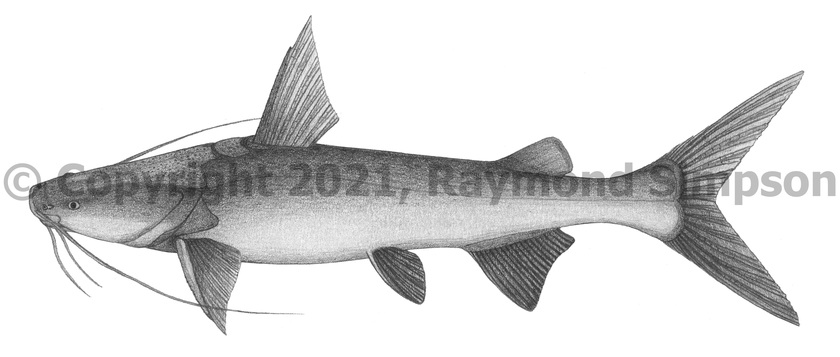
Common Name
Gillbacker Sea Catfish
Year Described
Trail, 1832
Identification
Dorsal Fin: I, 7
Anal Fin: 17-20
Pectoral Fin: 11-12 rays
Pelvic Fin: 6
Caudal Fin: 13 branched (6 upper, 7 lower)
Gill Rakers: 15-17 (first arch), 15-17 (second arch)
Sciades is defined by the combination of the following characters described in Marceniuk & van der Steen (2017): medial fleshy groove absent or present, a tiny fenestra between frontal and lateral ethmoid, posterior cranial fontanel closed, epiooccipital projecting into dorsal shield, occipital process short and tapering posteriorly, nuchal shield small/medium sized and crescent-shaped, vomerine tooth patch present, accessory tooth plates long, and adipose fin as long as anal fin.
Body elongate and robust with a strongly arched back. Head flattened. Greatest body depth at dorsal fin. Snout broadly rounded or squared off. Nostrils with furrow absent. Anterior nostril fleshy and posterior covered by a flap. Cephalic shield large and rough; extends well forward to between eyes with a shallow indent in the middle of the head. *Supraoccipital process short but wide at the base, without a defined keel and tapering posteriorly. Contact point of process and nuchal plate without a notch. Nuchal plate moderate, rough, and shield-shaped. Mouth subterminal. Eye relatively small. There are three pairs of barbels (one maxillary and 2 mental) with the maxillary barbel reaching well past the pectoral fin base (to anal fin in juveniles). A single arched patch of villiform teeth cross maxillary. Vomerine teeth present as two oval patches. Accessory patches with moderate posterior extensions in adults and barely separated from vomerine patches. Dorsal fin high with a strong serrated spine. Pectoral fins about the same size as dorsal fin with strong, weakly serrated spines. Pelvic and anal fins located far back on body. Adipose fin as long as anal fin. Caudal fin strongly forked. No rakers on rear of gill arches. Swimbladder well developed with three chambers. Body naked.
Color
Variable from golden or olive to dark steel gray above and grading to whitish below. Fins brownish to golden. Lobes of caudal fin often darker.
Size
A large species: maximum size to around 190cm TL. Usually 60-90cmTL.
Habitat
Found in brackish and marine waters around river mouths with high sediment loads.
Range
Eastern Venezuela (Gulf of Paria) to northern Brazil (Amazon mouth).
References
Acero, A. 2002. Ariidae (pp 831-852). In: Carpenter. 2002. The living marine resources of the Western Central Atlantic. Vol. 2: Bony fishes part 1 (Acipenseridae-Grammatidae). FAO Species Identification Guides for Fisheries Purposes. American Society of Ichthyologists and Herpetologists Special Publication No. 5.
Marceniuk, A.P. & van der Steen, P. 2017. Family Ariidae. In: van der Sleen, P., & Albert, J.S. (Eds.). 2017. Field guide to the fishes of the Amazon, Orinoco, and Guianas (Vol. 115). Princeton University Press.
Other Notes
The only Sciades with a weak or absent nasal furrow. Sciades parkeri and S. proops are different from the other three species in body shape, nuchal plate size/shape, swimbladder presence, and eye position much closer to snout tip. The supraoccipital process is block-like and does not indent into the nuchal plate.